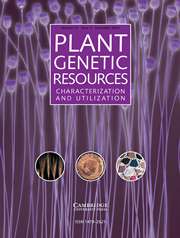Ver ítem
- xmlui.general.dspace_homeCentros Regionales y EEAsCentro Regional Buenos Aires NorteEEA PergaminoArtículos científicosxmlui.ArtifactBrowser.ItemViewer.trail
- Inicio
- Centros Regionales y EEAs
- Centro Regional Buenos Aires Norte
- EEA Pergamino
- Artículos científicos
- Ver ítem
Genetic diversity and linkage disequilibrium in the Argentine public maize inbred line collection
Resumen
Knowledge of linkage disequilibrium (LD) patterns is considered a prerequisite for effective association mapping studies. However, no LD analysis in the Argentine public temperate maize collection has been reported to date. In this study, a panel of 111 temperate maize inbreds genotyped at 74 single sequence repeats (SSRs) loci was used to assess LD, genetic diversity and population structure to evaluate the suitability of the panel for association
[ver mas...]
Knowledge of linkage disequilibrium (LD) patterns is considered a prerequisite for effective association mapping studies. However, no LD analysis in the Argentine public temperate maize collection has been reported to date. In this study, a panel of 111 temperate maize inbreds genotyped at 74 single sequence repeats (SSRs) loci was used to assess LD, genetic diversity and population structure to evaluate the suitability of the panel for association mapping. Mini-core sets were also designed for in-depth phenotyping and allele mining purposes. The panel consisted of: (1) locally developed orange flint germplasm; (2) temperate inbred lines with Iowa Stiff Stalk Synthetic background; and (3) eight historic flint lines, some of them from the Cuarentín race. As a result, four subpopulations were defined. Joint analysis of population structure and combining ability allowed identifying two main heterotic patterns. High molecular diversity, a low extent of LD and a high ratio of linked to unlinked SSR loci pairs in significant LD were detected indicating the suitability of the entire collection for association mapping. The fact that the LD extent in the mini-core sets was similar to that observed in the entire collection and that only a small percentage of allelic richness was reduced suggests that these mini-core sets are suitable to capture diversity, exploit phenotypic variance and discover useful variants representative of the entire collection.
[Cerrar]

Fuente
Plant genetic resources 5 (6) : 515-526. (December 2017)
Fecha
2017
ISSN
1479-2621 (Print)
1479-263X (Online)
1479-263X (Online)
Formato
pdf
Tipo de documento
artículo
Palabras Claves
Derechos de acceso
Restringido
 Excepto donde se diga explicitamente, este item se publica bajo la siguiente descripción: Creative Commons Attribution-NonCommercial-ShareAlike 2.5 Unported (CC BY-NC-SA 2.5)
Excepto donde se diga explicitamente, este item se publica bajo la siguiente descripción: Creative Commons Attribution-NonCommercial-ShareAlike 2.5 Unported (CC BY-NC-SA 2.5)

